If you’re planning to upgrade the wheels on your car, there’s a concept you should know about — wheel offset and backspacing.
Offset and backspacing are essentially two different ways of looking at the same thing. They are measurements that determine how far in or out your wheels will sit when they’re bolted on to your hubs.
Understanding these measurements will help you to avoid fitment and clearance related problems when you’re shopping for new wheels. In this article, we’ll explain what offset is, how it’s important, and everything you need to know before changing it.
What Is Wheel Offset?
Wheel offset represents the distance between the centerline of the wheel and the surface where it mounts to your hub.
It’s important to install wheels with the right offset so that they don’t rub against your fenders, brake calipers, and / or suspension components.
Negative vs Positive Offset
Rim offset can either be positive, negative, or zero. Here’s how the three types differ:
- Zero offset: Mounting surface is exactly in the center of the wheel
- Positive offset: Mounting surface is further away from the centerline, towards the street
- Negative offset: Mounting surface is tucked inside the centerline, towards the suspension
To visualize this, look at a wheel from the top and picture an imaginary line that represents its inner mounting surface. Now, if this line is visibly in the center of the rim, it means that the wheel has zero offset.
If you look at a positive offset rim from the top, you’ll notice that the imaginary line moves towards the street side and appears offset from the center; think asymmetric.
On a negative offset rim, you’ll notice that the line moves inside towards the suspension components. “deep dish rims” will ring a few bells here.
Here’s an example to make things easier.
+40 offset means that the mounting point of your wheel is 40 mm away from the centerline, towards the street side. Most vehicles come with a factory offset of about +12 to +20.
In this case, assuming that your original offset was zero, if you switch to a +40 offset rim, your wheel will be tucked in by 40 mm. The same applies to negative offset wheels.
-10 offset means that the mounting surface of your wheel is 10 mm away from the centerline, towards the inside. So if you switch from a zero offset wheel to a -10 offset wheel, it’ll pop out by 10 mm.
Why Change Your Wheel Offset?
Rim offset is not something that should be changed or messed around with unless you’re going after a very specific result. There are many reasons why you’d want to go for negative, positive, or zero offset wheels.
Car guys change their offset usually when they’re switching to a new set of wheels. It is done in order for a certain type of wheel to fit properly. The two main goals include:
- More stable handling
- Better stance / wheel fitment
When you’re shopping for a new set of rims, you’ll notice that the same options are available with different offsets to choose from.
The main question is, what measurement would you choose, and why? The answer depends on whether you’re looking for form or function.
Negative Offset: Advantages
Remember, negative offset pushes your wheels outwards. Apart from better looking wheel fitment, the main reasons why you’d want to do this include:
Wider Track
Your car’s wheelbase and track are major determinants of how it’s going to handle. Even small changes in these two measurements can make or break your driving experience.
Wheelbase is the distance between the two wheels on the front and rear axle; it impacts the length of the car. Track, on the other hand, is the distance between the centerline of two wheels on the same axle (side-to-side). Track impacts the width of the car.
Using negative offset wheels will instantly give your car a wider track; this can be either good or bad depending on what you plan on doing with it. If you take it to the track often, this could be a good thing. However, you need to consider what you’re gaining and giving up at the same time.
Wider wheel track will give you better stability while cornering at the expense of reduced feedback. Steering feel is an important factor that brings about a certain intuitiveness when driving at the limit; it allows your hands to let your brain know what the wheels are doing.
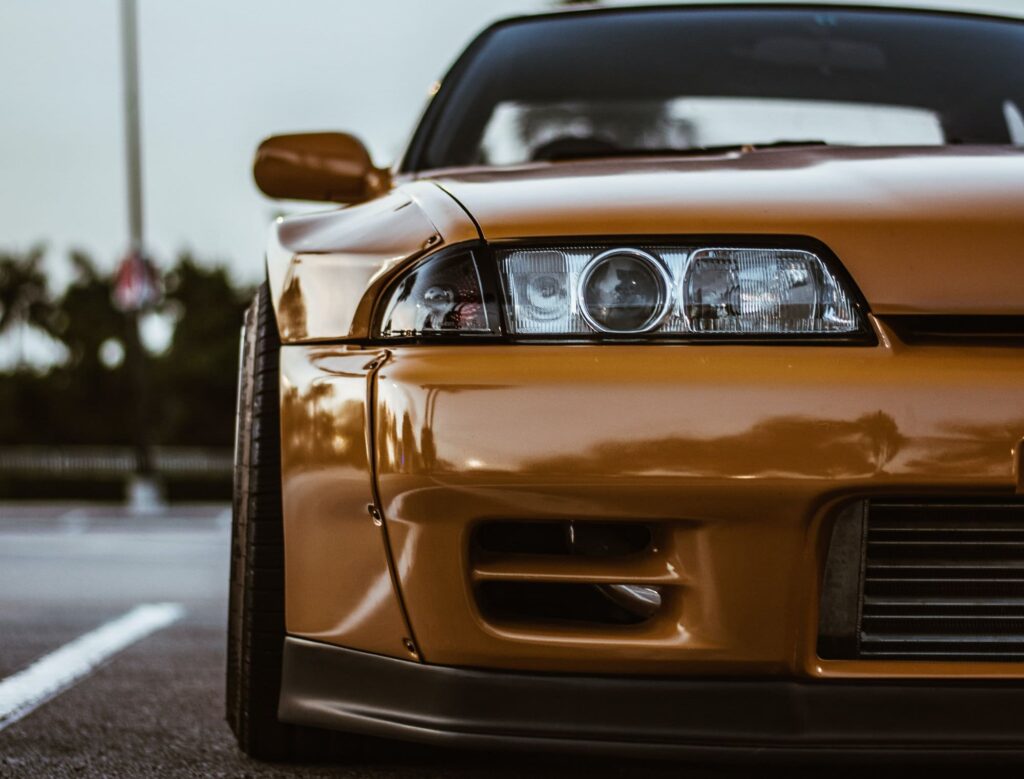
That said, while you have more grip, you won’t know exactly when the wheels are about to lose traction if such a situation might occur. Many early model Porsches are plagued with this issue, resulting in snap oversteer.
Interestingly however, the same rules change slightly when it comes to off road vehicles. Widening your track using negative offset rims will push the tyre sidewalls outwards, allowing them to grip better on slushy and rugged terrain.
Better Stance
If you’re a hard parker who’s heavily influenced by the stance scene, negative offset wheels are going to put an ear to ear grin on your face. Tastefully installed deep dish rims look pretty sick, and they’ll significantly improve the stance of your car.
This goes hand in hand with what we discussed in this guide to camber. When it comes to modifications that are just for cosmetic purposes, some people will love it, others will hate it. Do what feels right for you.
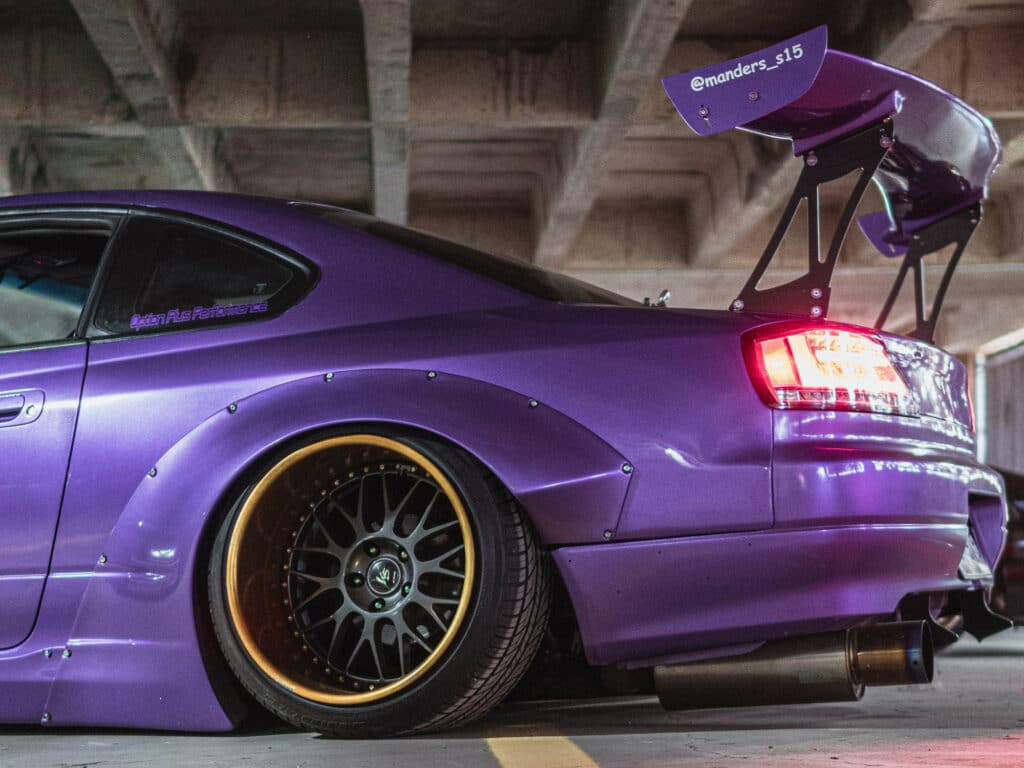
Negative Offset: Disadvantages
While changing your offset, think of it as fine tuning; even a few millimeters could make a night and day difference.
Excessive negative offset can do more harm than good. Common issues include:
Premature Wear of the Axle, Bearings and Driveline
The wider your track, the more leverage you’re putting on your axle, bearings, hubs, and driveline — especially if you’re carrying a lot of weight.
Most manufacturers select their bearings and wheel hub capacities based on the factory wheels. When you lower your offset, invest in more frequent inspection of ball joints, king pins, and bearings depending on what you have.
Yeah, that’s right, buy yourself a good ball joint press kit because you’re going to need it!
If, for whatever reason, you must have a lot of negative offset, we recommend upgrading your axle, hub and bearings to mitigate the excess stress.
Fender Rubbing Issues
When your wheels pop out wider than they’re supposed to, your front wheels will most likely rub against your fenders when they’re turned lock to lock.
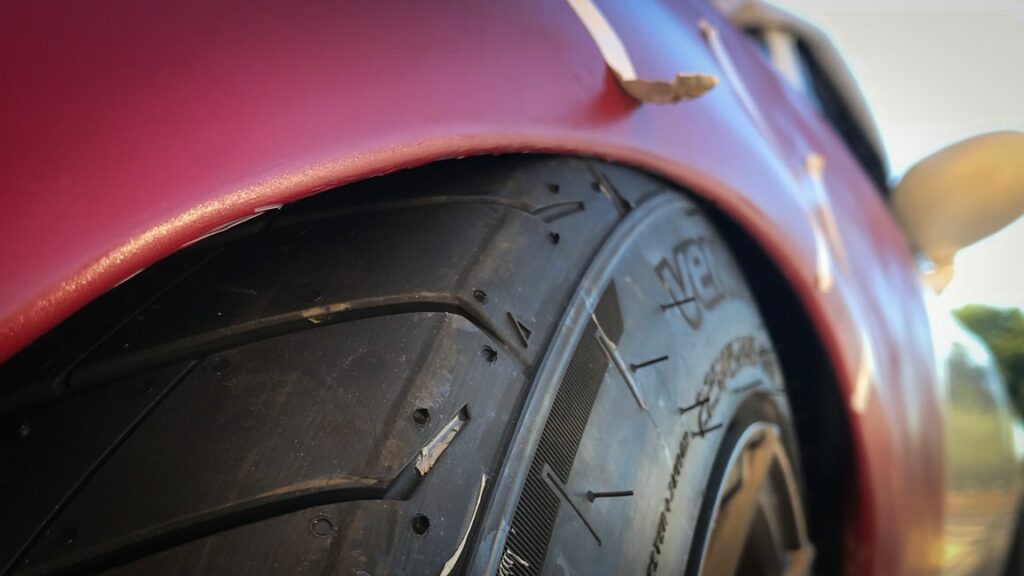
To solve this problem, you can roll your fenders and stretch your tires to get a better fit. This doesn’t always get rid of 100% of rubbing however.
Positive Offset: Advantages
Positive offset is responsible for tucking your wheels inward. Unlike negative offset, positive offset is safer and is generally preferred by most car manufacturers. Advantages include:
Easier to Fit Wider Tires
This advantage is applicable mostly for off road vehicles that have ample clearance inside the wheel well. If you want to fit wider tires without having them stick out, positive offset rims will allow you to do just that.

Neatly Tucked Tires
In our wheel camber article, we discussed essential JDM wheel styling guidelines.
If you want your wheels to tuck nicely inside your fenders, known as “Tsuraichi”, you’ll likely need higher offset wheels to achieve this.
Eliminate Guard Rubbing Issues
Sometimes, when you fit wider tires in the front, you’ll notice that they rub against the fender. To avoid this, you can use positive offset rims.
Do remember that all calculations need to be done before you purchase your desired set of wheels and tires.
Positive Offset: Disadvantages
Clearance issues are the only major downside of positive offset wheels. If you have enough room in your wheel cavity, then you can enjoy the advantages of positive offset.
If you’re low on space however, you might experience the following problems…
Upper Control Arm Scrubbing (For Independent Front Suspension Vehicles)
Vehicles with independent front suspension can have trouble with scrubbing of upper control arms.
Before making any changes to your wheel setup, it is vital to account for the wheel’s entire movement spectrum. This includes sideways movement while turning, and vertical movement when going over bumps.
If you fail to do this and install positive offset wheels, you might end up with expensive damage from the edge of the wheel and tire rubbing against your suspension components.
Clearance Issues With Brake Parts
If your brake caliper is dangerously close to your rim, chances are that you’ll face clearance issues.
0.3 mm might seem like enough clearance to most enthusiasts, however you need to account for the fact that your rim will flex quite a bit when banking through hard corners, and that your calipers will expand due to excessive heat build-up.
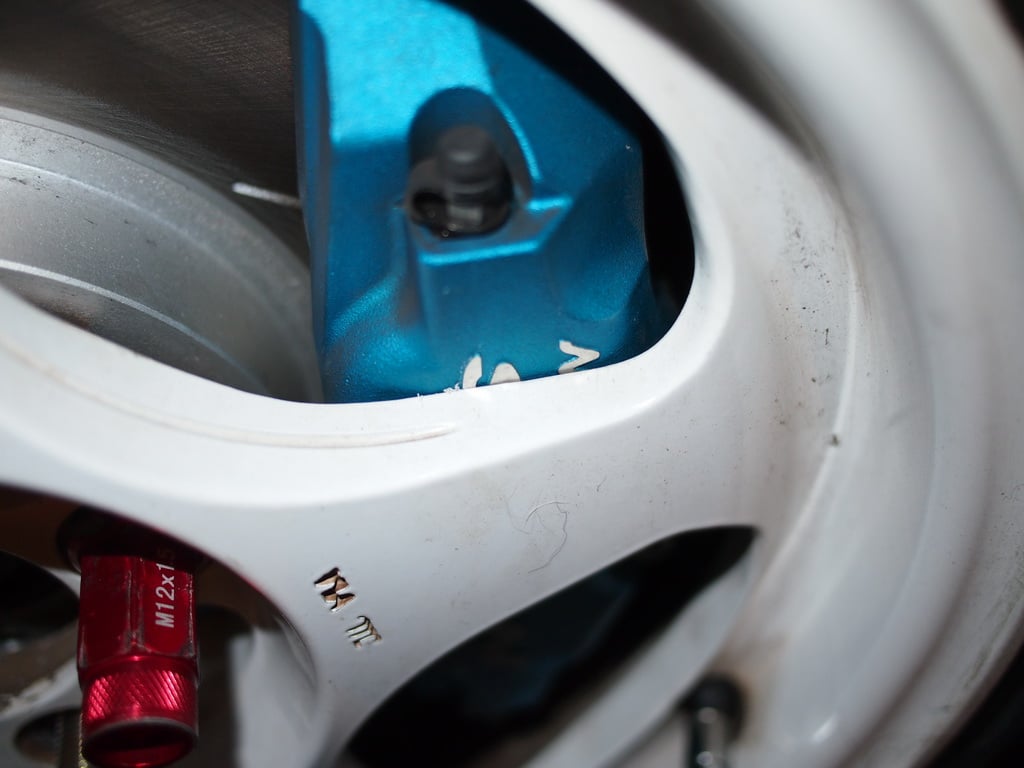
The last thing you want in this scenario is for your brakes to get damaged by the wheel.
Risk of Tire Failure
As mentioned above, your suspension components, brake calipers, and tires are at risk if you install positive offset wheels without having enough clearance.
The worst case scenario when it comes to tires is that they can tear up due to excessive rubbing.
Wheel Offset vs Backspacing
Offset and backspacing are two different ways of measuring how a wheel will mount on your car and whether or not it’s going to leave room for other components.
While they basically measure the same thing, the two are very different and need to be considered as two separate measurements.
Here’s a clear explanation of the difference between wheel offset and backspacing:
- Offset: Measured from the centerline of the wheel to the mounting surface
- Backspacing: Measured from the outer edge of the back side of the wheel to the mounting surface
Lower backspacing (negative offset) = More wheel clearance on the inside
Higher backspacing (positive offset) = Reduced wheel clearance on the inside
It is important to know this especially if you have any mods that might cause clearance problems with your wheels or tires when they’re pointed straight or turned either right or left at full lock-to-lock.
You may find it helpful to look at this image from earlier in this article again.
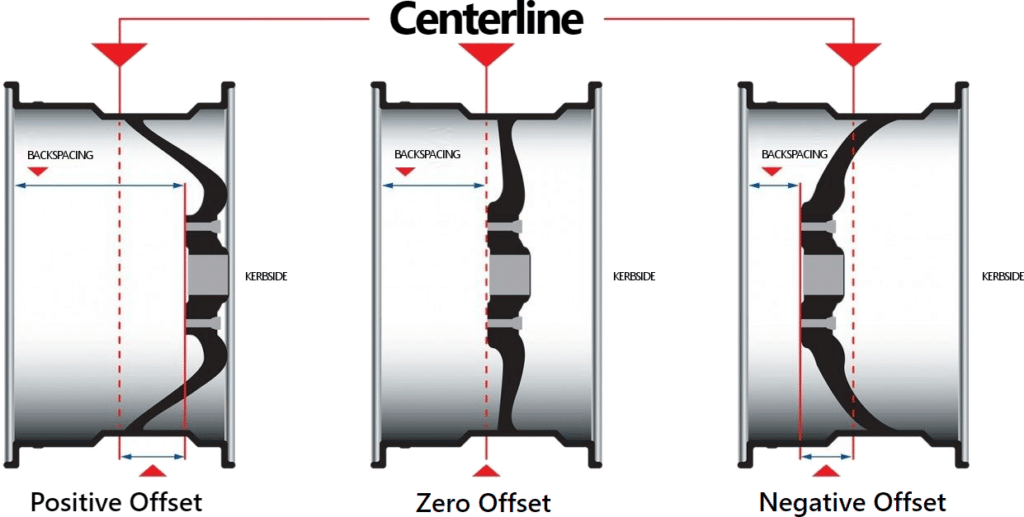
How to Measure Offset and Backspacing at Home
Most OEM and aftermarket wheels have a sticker or a laser etched print that mentions the offset. Oftentimes however, they just don’t mention it on the rim.
Suppose you get a sweet deal on a used set of wheels and you have no idea what the offset is, you can easily measure wheel size using a straight edge, a ruler, and a calculator.
Here’s what you need to do:
Step 1: Calculate Centerline
- Lay the rim flat on its face.
- Place the straight edge horizontally on the rim, and the ruler vertically in a way that they intersect. The vertical ruler will measure from the floor to the outer edge of the rim where the horizontal straight edge is placed. The measurement you get is the full width of the wheel. Let’s call it W.
- Now, divide W by 2, and you’ll obtain the wheel centerline. Let’s call that C.
Step 2: Calculate Backspacing
- Keep the same setup as mentioned above, only this time, instead of using the vertical ruler to measure from the ground, use it to measure from the mounting surface. This way, you’re measuring from the mounting point to the outer edge of the rim.
- Doing this will give you the backspacing; let’s call it B.
Step: Calculate Offset
- If B is greater than C, that means it’s a positive offset wheel. If B is lower than C, then it’s a negative offset wheel.
- To calculate offset, simply subtract C from B
For example,
Wheel Width (W) = 244 mm
Centerline (C) = 122 mm
Backspacing (B) = 175 mm
Offset = Centerline – Backspacing
So in this case, offset (O) = 175 – 122 = +53
The Relationship Between Wheel Offset and Scrub Radius
Before making any changes to your wheels, even if it’s as small as 10 mm, you need to know that these changes will impact your car’s scrub radius.
If the change is not suitable for your suspension geometry, it can potentially end up making your car drive worse than it did before.
Even the slightest changes in offset, and scrub radius as a result, can make an enormous difference to the way a car turns, accelerates, and brakes.
To understand scrub radius, picture two imaginary lines, one represents the steering axis, and the other represents the wheel centerline. Inevitably, these two lines will intersect at some point.
If they do so below the tire contact patch (below the road surface), then you have a positive scrub radius. If they intersect above the contact patch, you have a negative scrub radius.
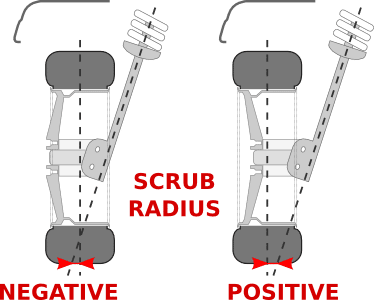
Here’s how this can impact your drivability.
Positive Scrub Radius: Steering effort increases because the wheel has to scrub around a larger contact patch. Torque steer sets in and a considerable amount of kickback is felt. The main advantage is improved feedback and road feel.
Negative Scrub Radius: Most front wheel drive cars use negative scrub radius. It’s like the best of both worlds; you’ll experience a moderate amount of steering effort, torque steer and kickback at the expense of lowered road feel.
Zero Scrub Radius: Car steers easily and has little to no steering kickback when driving over bumps. This happens at the expense of lost road feel and directional instability while cornering.
You’re probably thinking that all three sound bad, and they do, on paper at least. In reality, every car and driving application demands a different amount of scrub radius.
For example, track-focused cars use a lot of scrub. This is fine as long as you don’t drive over a bed of rocks.
We cannot list the effects of offset and scrub radius change on all types of cars and suspension assemblies; there are too many permutations and combinations out there.
So before you change your offset, we strongly recommend considering its impact on your suspension geometry. Be certain that you aren’t damaging your suspension, or worse, making your car unsafe to drive.
Wheel Spacers vs Low Offset Rims
It’s often debated whether wheel spacers and lower offset rims are interchangeable. The topic is worth discussing because spacers are insanely cheap compared to rims.
For example, a 10 mm spacer, and a rim which has 10 mm lower offset than your stock wheel will effectively do the same thing — push your wheel out by 10mm.
However, the two should not be thought of as interchangeable parts. Spacers have a specific purpose; they’re perfect if you want an existing set of wheels to sit much nicer.
Without spacers, some aftermarket rims can sit too far in. Adding a spacer to your new wheels can give you the look you’re after, without having to break the bank.
The main downside of wheel spacers is that they might induce some amount of wheel play; especially if they’re bad quality or poorly fitted.
Understanding Offsets
At the end of the day, it’s your car, and you can do whatever you want with it. Our main recommendation is that you know exactly what you’re getting into before you reach a point where there’s no going back.
Simply knowing your stuff can save you a lot of unnecessary repair costs. Now that you know what offset is, what exactly it does, and why you might change it, you’ll be in a much better place to make a well calculated decision.
What wheels are you running? Would you rather install spacers and call it a day, or spring for a set of wheels in the perfect size? Let us know by dropping a comment below.


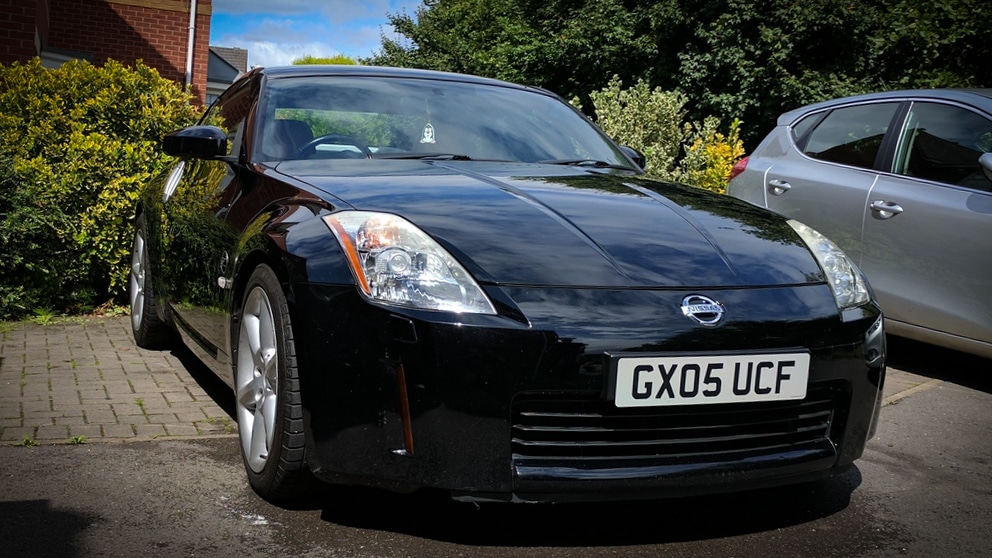
7 comments
I need a offset of 20 to clear suspension going with bigger tires with a lift an the wheels im running are a 37 offset. How do I get my wheel closer to a 20 offset? Or will a 37 offset sit further from suspension say an offset of 20?
The only way to “change” your wheel offset is to run spacers. If your wheels are +37mm and you need to lower that to +20mm, you’ll need to find a 15mm wheel spacer to suit your car.
Great article. How much is too much offset change? I have a +55 offset AWD car, but there just aren’t any wheels I like with that offset. But there are lots of choices in the +35 to +38 range. I have heard some people say do not change over 10mm but then I read in other forums that 20mm is not an issue. But once the tires and rims are purchased, there is no going back if the drivability sucks. Also, can I modify the scrub radius with camber plates to help with the offset change? Thanks….
I am in the same boat with my ML350.
Same 55+ offset down to 35+ offset hence they will stick out 20mm
Did you get the 35+ or something closer to original offset?
Cheers
Hi,
This section on offset and backspacing and everything else was great! I’m not that versed in tires and wheels, especially aftermarket products so your writing helped me understand what to look for with my idea of switching to non-OEM wheels. Thanks a lot.
Brian in Napa, CA
My son bought some 255/55/r18 tires with method racing NV305 size 18 rims for his 2001 toyota four runner. Previous owner had 20-inch rims on it. He bought the wheels with a -12 offset and I’m worried they stick to far out of the wheel well. It looks good and gives his truck a wide stance but will damage be done to the undercarriage? They turned the wheel lock to lock and no rubbing. Will this change the handling of the truck? Thanks from a worried mom 🙂
Awesome explanation of wheel offset! Thank you!